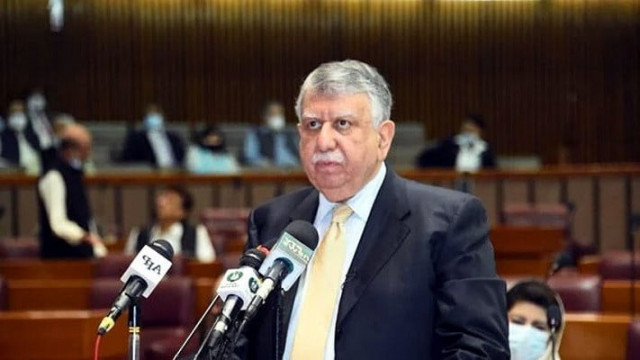Tarin unveils three-year plan to shore up economy
Second long-term plan of PTI govt lacks solid targets, implementation cost

In its fourth year in power, the government on Friday unveiled another long-term economic roadmap – its second in as many years –which seeks to cancel already approved foreign loans and a two-year ban on fresh foreign borrowings aimed at scaling back the growing debt pile.
Finance Minister Shaukat Tarin released the synopsis of ‘the 2021-24 Roadmap for Inclusive and Sustainable Growth’ along with members of the Economic Advisory Council (EAC) and federal ministers.
However, the report shared with the media lacked specific targets and end objectives as well as carried a few contradictions that could undermine the seriousness with which this work had been done by the EAC.
On page eight of the report, it is suggested to increase the tax-to-GDP ratio by 1.5% to 2% annually but on page nine one per cent target is given. The year for achieving the short- and medium-term goals is the same – the fiscal year 2021-22. The report did not mention the cost of implementing the highly ambitious plan, which would also require the nod of the International Monetary Fund (IMF).
To reduce the foreign debt, the roadmap seeks to “cancel drawdowns on wasteful foreign loans and two-year moratorium on foreign borrowings”.
“The policy of taking loans from the World Bank and the Asian Development Bank (ADB) must end now,” Mohammad Ali Tabba, a leading industrialist and member of the EAC, said.
However, this goal seems contradictory to the government strategy to borrow nearly $20 billion in this fiscal year to remain afloat, including borrowing through highly expensive Naya Pakistan Certificates.
The finance minister-led and owned roadmap also acknowledges that the country was paying very high interest rates on the Naya Pakistan Certificate debt and seeks to “review the interest rates”. The roadmap also seeks a reduction in the policy rate by the central bank and to rationalise the tax expenditures for reducing the domestic debt.
When the PML-N left the government the total public debt was Rs25 trillion that has already jumped to around Rs38 trillion.
It is the second long-term economic roadmap that the Pakistan Tehreek-e-Insaf government has launched in two years. The first plan was launched by former finance minister Asad Umar days before his removal in April 2019.
“I am not responsible for the performance review of the past plans but Asad Umar had tried to implement that,” Tarin said while responding to a question.
Tarin admitted that the government had only two years left in its five-year term and during this period it could only implement a short-term agenda. He added that the three-year plan reflected the government’s intentions and time would tell whether or not it was implemented successfully.
“The relevant ministries will be answerable to the prime minister every month about the progress being made on achieving these objectives,” Tarin said.
The plan seeks to curtail the public sector development spending by “immediately shelving unviable projects, transfer projects to provinces and limit approval of new projects”. But this goal seems in contradiction to another goal of increasing investment-to-GDP ratio from a very low level of 13.9%.
The investment-to-GDP ratio had to be doubled to 24% for sustainable economic growth, Syed Salim Reza, a member of the EAC and a former governor of the State Bank of Pakistan (SBP), said.
He added that 55% of the total banking sector credit was taken away by the government while 90% of the remaining credit was taken by big companies, leaving nothing for small businesses.
Answering questions about the plan’s vetting by the IMF and whether the government would still stay in the programme, Tarin said that Pakistan was very much in the IMF programme.
“I’ve had productive discussions with the IMF on Thursday. The talks with the IMF will be held by the end of September and then there will be face-to-face meetings in October in Washington,” Tarin said, adding that the IMF programme would not be called off and it would continue as per plan.
When he was asked how much money was needed to implement the plan, Tarin said that at least 60% to 70% recommendations have already been implemented and their cost was covered in this year’s budget.
The plan is shallow on many counts. For instance, no explicit targets are given to curtail the circular debt. The general statement is made about flattening the capacity payment curve by replacing cross subsidies with targeted subsidies and improving governance without giving specific deadlines.
Tarin said that the government had put in place a comprehensive roadmap focusing on 14 special sectors of the economy to ensure planned, inclusive and sustainable economic growth in the country.
The minister said that it was after the year 1972 that such a strategy was being presented by the government under which short-, medium- and long-term plans were being devised by working groups in consultation with the stakeholders, and their implementation would be monitored.
The minister said that from September, performance in these 14 sectors would be monitored and the prime minister would be given briefing about the execution of the plans every month.
He said that the exercise was aimed at accelerating growth rates from 3% to 6% in three years, keeping inflationary expectations subdued, generating employment opportunities, and reducing poverty by strengthening social safety nets.
On the occasion, Prime Minister’s Adviser Razak Dawood said that his main focus was on increasing exports which would help strengthen the country’s economy. He added that the government had set the export target at $38.7 billion for the current fiscal year, of which $31.2 billion export target is fixed for goods.
In three to four years, the target would increase to $40-50 billion from the current less than $26 billion, Tabba said.
Industries Minister Khusro Bakhtiar said that keeping in view the higher large-scale manufacturing (LSM) sector growth, the gross domestic product (GDP) growth which provisionally remained at 3.9% in the previous year could go up to 4.5%, when the final figures would be calculated.
The minister informed the media that new industrial sectors would be introduced that would help raise exports and substitute the imports of the country.



















COMMENTS
Comments are moderated and generally will be posted if they are on-topic and not abusive.
For more information, please see our Comments FAQ